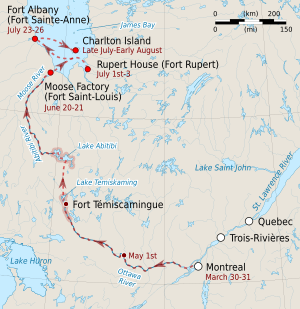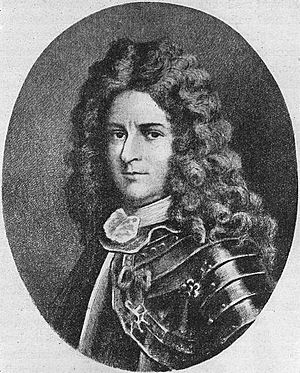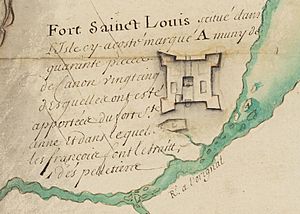Hudson Bay expedition (1686) facts for kids
Quick facts for kids Hudson Bay expedition |
|||||||
|---|---|---|---|---|---|---|---|
| Part of King William's War | |||||||
 Map of the expedition. |
|||||||
|
|||||||
| Belligerents | |||||||
| Commanders and leaders | |||||||
| Strength | |||||||
| 100+ | 40 3 trading posts 1 merchantman |
||||||
| Casualties and losses | |||||||
| unknown killed and wounded | unknown killed and wounded 3 trading posts captured 1 merchantman captured |
||||||
The Hudson Bay expedition of 1686 was an important event in the history of Hudson Bay. It was the first time that New France sent soldiers to attack the trading posts of the Hudson's Bay Company (HBC). These posts were located in the southern part of Hudson Bay.
The expedition was led by a French soldier named Chevalier de Troyes. His team successfully captured several trading posts. These included Moose Factory, Rupert House, and Fort Albany. They also took control of the HBC ship named Craven.
Even though France and England were at peace in 1686, a bigger war started in 1689. This war was called the Nine Years' War. The fight over the Hudson Bay trading posts continued. One of Troyes' officers, Pierre Le Moyne d'Iberville, led more attacks against the HBC. These fights ended with a French victory in the Battle of Hudson's Bay in 1697. By the end of the war, the French controlled almost all of the HBC's trading posts.
Contents
Why the Expedition Happened
In 1679, a French explorer named Pierre-Esprit Radisson and a businessman named Charles Aubert de La Chesnaye met in Paris. They decided to start a company called the Compagnie du Nord. Their goal was to trade furs in northern North America. The English Hudson's Bay Company (HBC) was already making a lot of money from this business.
The Compagnie du Nord's first big trip in 1682 was successful. They managed to take over York Factory. However, the government in New France put high taxes on their profits. This made the Compagnie lose almost all its money. Because of this, Radisson decided to work for the HBC instead. He led several successful trips to Hudson Bay, helping the HBC get back York Factory and the furs that were taken.
Later, the Compagnie du Nord convinced the governor of New France, Marquis de Denonville, to plan a military attack. This attack would be against the HBC's trading posts on Hudson Bay. Governor Denonville chose Pierre de Troyes, Chevalier de Troyes to lead the mission.
Troyes put together a small group for the journey over land. It included 30 French regular soldiers and 70 Canadian volunteers. A few Native American guides also joined them. Among the Canadians were three brothers who later became very famous: Pierre Le Moyne d'Iberville, Jacques le Moyne de Sainte-Hélène, and Paul Le Moyne de Maricourt.
By 1686, the Hudson's Bay Company had built several trading posts. These were located in Hudson Bay and James Bay, which is a smaller part of Hudson Bay. Moose Factory and Rupert House were built on rivers that flow into James Bay. Besides York Factory, there were also posts on the Albany and Severn Rivers. These rivers flow into Hudson Bay on its western side. All these posts were wooden forts with some cannons. Fort Albany was the strongest and had the most defenses.
The Journey and Attacks
The expedition started from Montreal in March 1686. They traveled more than 800 miles (1,300 km) over 82 days. North of Fort Témiscamingue, no white men had explored the route before. They went up the Ottawa River to Lake Timiskaming. Then they carried their canoes over land (portaged) and went down the Abitibi River and Moose River.
When they reached Moose Factory, 16 men were guarding it. The governor, John Bridgar, had left for Rupert House the day before. Before dawn, the brothers Pierre and Jacques Le Moyne led their teams quietly into the fort. They tied down its three cannons before attacking the sleeping guards. Pierre Le Moyne fought his way into the building where the defenders were. But the defenders closed the gate behind him. He had to fight alone with his sword and musket until his soldiers forced the gate open. After a two-hour battle, the guards gave up.
De Troyes left 40 of his men to guard Moose Factory. He then led the rest towards Rupert House, which was about 75 miles (120 km) northeast across James Bay. Again, they attacked a sleeping group of guards. They got into the fort using a ladder that someone had left against a wall. They also captured the HBC ship Craven. This ship had carried Governor Bridgar from Moose Factory.
De Troyes sent the captured people to Moose Factory. He then sent d'Iberville and the Craven to attack Fort Albany. The ship carried heavy cannons from Rupert House. Fort Albany was on the west side of the Bay.
Fort Albany could not be seen from the water. De Troyes spent some time looking for it. Its location was finally revealed when one of the fort's cannons was fired at sunset. The French unloaded their heavy guns and dragged them to the fort. After firing into the fort without any shots back, they heard faint shouts of "Vive le Roi!" (Long live the King!) from inside. The men in the fort were hiding in the cellar. Other stories say there was more fighting.
De Troyes sent all the captured HBC people to Charlton Island. A company supply ship eventually picked them up there. He then left d'Iberville and 40 men to hold the captured posts. De Troyes himself returned to Montreal by land.
Fort Moose (now Moose Factory, Ontario) changed hands a few times. But in 1713, the area officially became British territory under the Treaty of Utrecht.
What Happened Next
After spending the winter in the north, d'Iberville traveled to Quebec, and then to France. There, he was given command of a ship called the Soleil d'Afrique. He returned to Hudson Bay in 1687 to get the furs that had been taken during the expedition. While he was at Fort Albany, two English warships arrived. Since England and France were at peace, the English ships stayed on a nearby island and did not attack. However, d'Iberville did attack. He captured the ships from the English, even though they had more men.
Meanwhile, King James II of England and King Louis XIV of France had tried to make a peace treaty. It was called the 'Treaty of Peace, good Correspondence and Neutrality in America'. This treaty was supposed to settle the conflict over Hudson Bay. It said that each side would keep whatever they 'now possessed'. France knew about the captured forts, but England did not. In 1688, King James II was removed from power. England and France went to war, and the treaty became useless.
Impact on Native Traders
When these three trading posts were taken by the French, the First Nations traders faced difficulties. They could not meet their trade needs as before. For example, after Fort Charles was destroyed in 1686, the Rupert River area had no English fort. This meant the Native traders had to travel to Eastmain or Moose Fort to trade.



